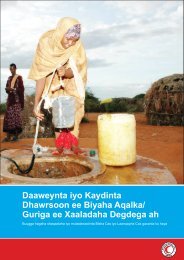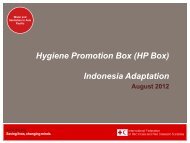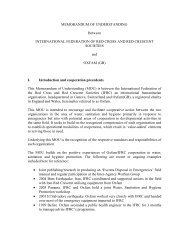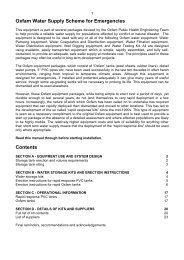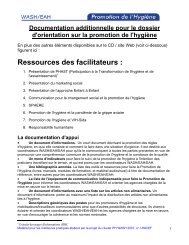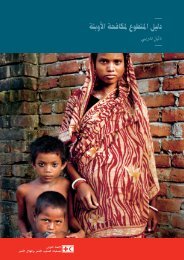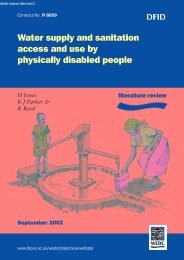Hygiene Promotion - IRC International Water and Sanitation Centre
Hygiene Promotion - IRC International Water and Sanitation Centre
Hygiene Promotion - IRC International Water and Sanitation Centre
You also want an ePaper? Increase the reach of your titles
YUMPU automatically turns print PDFs into web optimized ePapers that Google loves.
The programme has not been able to realise its very ambitious goals, but good progresson sanitation <strong>and</strong> hygiene has nevertheless been achieved. According to the data of theprogramme, sanitation coverage increased from 15% in 1985 to 32% in 1998 through theconstruction of about 500,000 VIP latrines. Under the central programme, some 5,000latrines were installed per year. When the programme was decentralized to the districts,this dropped to 10,000, but later on picked up to 20,000. This is still below the 30,000 peryear needed to cover the 3% population growth. Moreover, the actual installation data arenot well-known, <strong>and</strong> families may have opted for constructing simple pit latrines if theycould not get the 3 bags of cement (the incentive for a VIP latrine) from the districts.The partial success of the programme can be attributed to among others:• Institutional arrangements (UNICEF/IRISH aid have supported training <strong>and</strong> productionof materials). The government has also allowed different organisations to pilot <strong>and</strong>apply different approaches e.g. Health Clubs. The programme approach is that ofintegrating water, hygiene <strong>and</strong> sanitation through an intersectoral committee.• Methodologies used - these have allowed for communities to identify their realproblems <strong>and</strong> not perceived problems. They have also facilitated underst<strong>and</strong>ing ofcause <strong>and</strong> effects leading to desire to change. The development of methodologies wassupported by actual promotion instruments - the toolkits- <strong>and</strong> this has enabledextension workers to promote hygiene.• Rather than starting with policy, the ministry started by piloting the use of participatorymethods <strong>and</strong> then demonstrating to policy makers that it works. In this way theministry got endorsement.For more details, contact: Max Jonga, UNICEF, Harare; Mr. W. Rukasha, Ministry ofHealth <strong>and</strong> Child Welfare.Among the lessons drawn from the Zimbabwe experience, the project staff emphasize:• Many issues or factors have to be put in place to facilitate hygiene behaviour change.The format <strong>and</strong> combination of these factors is very much dependent on the localsituation <strong>and</strong> cannot be externally prescribed. This is seen as one of the main reasonsfor the success of the participatory PHE/PHAST in Zimbabwe.• <strong>Hygiene</strong> education should be undertaken both before <strong>and</strong> after the provision ofhardware interventions such as water <strong>and</strong> latrines. <strong>Water</strong> <strong>and</strong> sanitation facilities areby their very nature hygiene-enabling facilities, but the absence of a pump or a latrinedoes not imply that hygiene behaviour cannot be improved <strong>and</strong> we shouldn't limitourselves to the scope of the intervention. In fact in many communities where thereare no hygiene enabling facilities the need for improved hygiene behaviours is fargreater <strong>and</strong> the impact of improved hygiene awareness among communities oftenresults in the provision of enabling facilities through local innovations. <strong>Hygiene</strong>education is not just a once off message exchange, but rather an overall process,which will culminate in improved health.• To obtain the right policy environment <strong>and</strong> institutionalisation of hygiene education,advocacy is essential at all levels right from the community level to Ministerial level.Government departments, local Councils, NGOs <strong>and</strong> CBOs must have an40 <strong>Hygiene</strong> promotion



